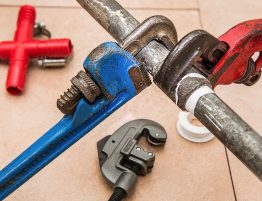
Photo courtesy of Bryant
In our climate, we tend to know more about our air conditioning (especially when it’s not working) than about our heating systems. How well do you know your heat pump? It it giving you its best, or just giving enough warmth to get by? Here’s what to watch for and when (and why) to call a pro.
How a Heat Pump Works
You might be used to having a heat pump, but not sure how it performs its heating magic, or if you recently relocated to Florida from a colder climate, you may not be familiar with heat pumps at all. A heat pump pulls warm air from the outside air (or ground, if you have geothermal heating) and pushes it inside to heat your home or business. This system is very energy-efficient because it just moves warmth from one environment to another instead of burning fuel to generate heat. And since it’s so good at transferring heat, the process can be reversed: instead of a separate air conditioner, a heat pump can do the job of cooling in warmer months. This single HVAC system can replace two separate units in some installations (if you’re currently shopping for heating or cooling appliances, talk to your licensed HVAC professional about whether this is a space-saving and energy-sipping option for you.
Keeping Your Heat Pump at Its Best
When the weather is moderate, the heat pump operates just by transferring heat back and forth, but what happens when it’s too cold (or hot, when in cooling mode) to heat or cool your home to a comfortable temperature?
In heating mode, a heat pump has two stages it can run. So when the heat pump alone can’t meet the required temperature set at the thermostat, the second stage—electric heat—kicks in. It’s a little like driving a hybrid car: when the car is at low speeds, it runs on electric, but at highway speeds the gas engine assists the battery for better performance. A healthy heat pump should run effectively on the first stage (heat transfer) as long as temperatures are well above freezing. The electric second stage should only engage when temperatures dip into the 30s or below.
Many of us wait to call a heating and cooling pro when we either don’t have heat… or cooling (or we have too much heat/cold but want it to be the opposite!). But the challenge with a heat pump is that because it can fall back on electric heat, it’s not easy to recognize when there’s a problem. In fact, you may not be able to wait until there’s no heat before getting your pump checked or fixed—because that day might not come.
So how can you tell when there’s a problem?
- Keep an eye on your electric meter and electric bill. A heat pump constantly running in electric mode will draw a lot of power. You should review your bill from month to month, but also check the charts on your bill that show what you used in the same time period last year. If your kilowatt usage increased significantly, a large electric appliance like you heat pump could be responsible.
- Don’t wait for a problem or a huge electricity bill to get your heat pump checked out. Call a licensed HVAC professional when the seasons change and consider a regular maintenance contract to keep ahead of potential problems and give long life to your heating system.
By keeping your heat pump and entire HVAC system maintained, you can enjoy optimal comfort in your home or business as you extend the life of the product. But when it’s time to replace your system, we’d love to help you select your heat pump from among the top quality brands we carry—so you can stay comfortable!







